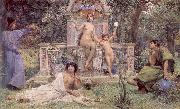Wholesale Oil Painting Reproductions No Minimum and Door to Door! |
|||||||||||
|
|
|||||||||||

|
|||||||||||
|
|
|
||||||||
All Merson, Luc-Olivier Oil Paintings |
||||||||
|
|
||||||||
|
|
||||||||
|
Artist Introduction: French Painter, 1846-1920
French painter and illustrator. He was the son of the painter and art critic Charles-Olivier Merson (1822-1902) and trained initially at the Ecole de Dessin in Paris under Gustave Adolphe Chassevent (1818-1901) and then at the Ecole des Beaux-Arts under Isidore-Alexandre-Augustin Pils. He made his d?but at the Salon in 1867 and won the Grand Prix de Rome in 1869 with the melodramatic work, the Soldier of Marathon (1869; Paris, Ecole N. Sup. B.-A.). As a prizewinner he then spent five years in Italy, where he was impressed and influenced by the works of the Italian Primitives, as is apparent in such works as St Edmund, King and Martyr (1871; Troyes, Mus. B.-A. & Arch?ol.), with its muted colours and rigid composition. In the Salon of 1875 he exhibited Sacrifice for the Country, St Michael, which had been commissioned as a design for a Gobelins tapestry for the Salle des Ev?ques in the Panth?on, Paris. Soon afterwards he was chosen to decorate the Galerie de St Louis in the Palais de Justice, Paris, with scenes from the life of Louis IX. This resulted in two large works, Louis Opening the Doors of the Gaols on his Accession and Louis Condemning Sire Enguerrand de Coucy (both 1877). He also used historical, often religious, subjects for his smaller-scale works, as in St Francis of Assisi Preaching to the Fish (1880; Nantes, Mus. B.-A.). |
||||||||
|
|
||||||||
|
Truth Painting ID:: 19404 |
1901
Mus??e d'Orsay, Paris. |
|||||||
Height Width |
INS/CM Quality |
|||||||
|
X |
| |||||||
|
|
||||||||
All Jules Joseph Lefebvre Oil Paintings |
||||||||
|
|
||||||||
|
|
||||||||
|
Artist Introduction: (Tournan-en-Brie, Seine-et-Marne, 14 March 1836 - Paris, 24 February 1911) was a French figure painter.
Lefebvre entered the École nationale superieure des Beaux-Arts in 1852 and was a pupil of Leon Cogniet. He won the prestigious Prix de Rome in 1861. Between 1855 and 1898, he exhibited 72 portraits in the Paris Salon. In 1891, he became a member of the French Academie des Beaux-Arts.
He was an instructor at the Academie Julian in Paris. He is chiefly important as an excellent and sympathetic teacher who numbered many Americans among his 1500 or more pupils. Some of his famous students were the Scottish-born landscape painter William Hart, as long as Georges Rochegrosse, Felix Vallotton, and many more. He was long a professor at the École des Beaux-Arts.
Many of his paintings are single figures of beautiful women.
Among his best portraits were those of M. L. Reynaud and the Prince Imperial (1874). Among his many decorations were a first-class medal at the Paris Exhibition of 1878 and the medal of honor in 1886. He was a Commander of the Legion of Honor and a member of the Institut de France.
|
||||||||
|
|
||||||||
|
|
Truth Painting ID:: 70689 |
Medium Oil on canvas
Dimensions Expression error: Missing operand for *265 ?? 112 cm
|
||||||
Height Width |
INS/CM Quality |
|||||||
|
X |
| |||||||
|
|
||||||||
|
Prev Next
|
||||||||
|
|
||||||||
|
Related Paintings to Jules Joseph Lefebvre :. |
||||||||
|
|
||||||||
|
CONTACT US |


